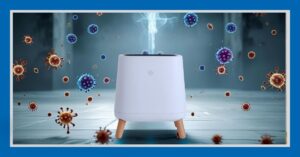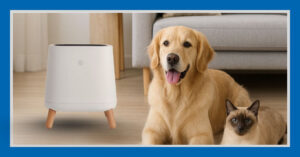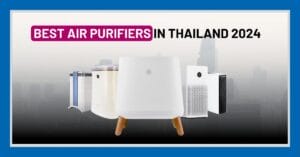Your cart is currently empty!

What Is A Hepa Filter? A Comprehensive Guide
by Karl von Luckwald / October 13, 2024
Have you ever looked inside an air purifier or vacuum cleaner? If yes, then you must have spotted a HEPA filter.
But what is a HEPA filter? And why are they so important for these devices?
In this article, we will go to the bottom of that question. We’ll explain simply what HEPA filters are and how they catch invisible particles that can harm our health.
So, if you’re curious about why the air coming out of your air purifier is clean, this write-up is for you.
So, What is a HEPA Filter?
A HEPA (High-Efficiency-Particulate Air) filter works by trapping airborne pollutants like dust and microbes. It uses a complex fiber mesh to catch particles through various mechanisms. It is commonly found in air purifiers and vacuum cleaners.
How Do HEPA Filters Work?
HEPA filter is an abbreviation for High-Efficiency Particulate Air filter.
They are mainly used to trap airborne particles like fine dust (PM2.5), viruses, bacteria, mold, pollen, and other pollutants.

You can find HEPA filters in air cleaners, HVAC systems, and vacuum cleaners. They help to keep the indoor air clean from particles that might be harmful to health.
A HEPA filter is made up of synthetic fibers arranged like a mat.
When viewed through a microscope, it appears as a network of interwoven fibers with small gaps in between. These gaps allow air to flow but are small enough to trap airborne particles.

Filtration Mechanisms
But how do HEPA filters trap particles? And what happens exactly as soon as dirty air passes through the fibers? Here’s a breakdown of the three primary filtration mechanisms at play:
Impaction
Particles larger than about 1 micron (50 times smaller than a human hair) get easily caught by the HEPA.
They’re simply too big to pass through gaps. Instead, they collide with the fibers and get trapped. Scientists call this process impaction.

Interception
Now, let’s talk about particles that range from 0.3 to 1 micrometer in size.
These guys are technically small enough to pass through the gaps. But their weight becomes their burden.
As they brush past the fibers, they adhere to them as they are too heavy. This mechanism is called interception.
It is crucial for capturing particles that are just small enough to avoid impaction but still large enough to be snagged by the fibers.

Diffusion
What about smaller particles than 0.3 microns? Like 10 times smaller. Or even 100 times smaller?
These must be uncatchable, right?
No, the opposite is the case. These lightweight particles don’t travel in a straight line. Instead, they move in what’s known as Brownian Motion; zigzagging and bouncing around erratically. This irregular movement makes them ultimately collide with a fiber.
This process called diffusion, is especially effective for particles smaller than 0.1 microns. It ensures that even the most elusive particles are captured, making HEPA filters incredibly efficient at purifying air.

The Significance Of 0.3-microns
So far we’ve learned that HEPA filters work great at trapping pollutants.
However, much like Batman’s recurring challenges with the Joker, HEPA filters always have a hard time with particles that are 0.3 microns in diameter.
0.3 microns are the most difficult for HEPA filters to trap.
0.3 microns are the most difficult for HEPA filters to trap.
They tend to be small enough to slip through the mesh. That’s why scientists call them “Most Penetrating Particle Size (MPPS)”

Although a HEPA filter will catch most of these, some will always escape. This is the reason why HEPA filters are labeled with a certain efficiency rating like H12 99.5% or H13 99.95%.
The percentage declares how efficient a HEPA filter is at capturing 0.3 microns.
A H12 filter, for example, captures 99.5% of all 0.3 microns in the first pass. And another 99.5% of the remaining 0.5% in the second pass – and so on.
HEPA Filter Efficiency Ratings
The use of the term “HEPA” is governed by strict standards.
In Europe, HEPA filters are required to capture 99.95% of particles, as per ISO standards. Meanwhile, in the US, they need to remove 99.97% of particles.
| Standard | Filtration Efficiency 0.3 Microns (MPPS) |
|---|---|
| ISO / European Standard | ≥ 99.95% |
| US Standard | ≥ 99.97% |
According to European and ISO guidelines, if a filter captures between 85% and just under 99.95% of particles, it falls into the category of EPA filters, short for efficient particulate air filters.
These don’t qualify as HEPA air filters due to their lower filtration efficiency.
Conversely, those that outperform HEPA air filters, capturing more than 99.999% of particles, are classified as ULPA filters, an acronym for ultra-low penetration air filters.
| Filter Class | Category | Filtration Efficiency 0.3 Microns (MPPS) |
|---|---|---|
| E10 | EPA | ≥85% |
| E11 | EPA | ≥95% |
| E12 | EPA | ≥99.5% |
| H13 | HEPA | ≥99.95% |
| H14 | HEPA | ≥99.995% |
| U15 | ULPA | ≥99.9995% |
| U16 | ULPA | ≥99.99995% |
| U17 | ULPA | ≥99.999995% |
Important to know: Before 2009, all filters were known as HEPA filters. But in 2009, the naming changed to EPA/HEPA/ULPA.
Most people are more familiar with “HEPA 11” than “EPA 11.” That’s why many brands still refer to the HEPA terminology.
What Are True HEPA filters?
The American standard is often referred to as “True HEPA.”
The term “true” comes from the US Military. They say a HEPA filter must catch 99.97% of particles that are 0.3 microns or bigger.
But this is just one way to measure filters.
And there’s no proof that “true HEPA” makes air filters work better than others.
What Are MERV Filters?
MERV filters (Minimum Efficiency Reporting Value) also capture particles, but they are less efficient than HEPA filters.
Generally, they offer less resistance to airflow compared to HEPA filters, making them more suitable for standard HVAC systems.
MERVs are rated on a scale from 1 to 20, based on their ability to remove particles of varying sizes (from 0.3 to 10 micrometers).
Higher MERV ratings indicate finer filtration, with MERV 16-20 filters being the most efficient in the MERV category.
What Are Medical Grade HEPA Filters?
When the whole world was clamoring for air purifiers during the Covid pandemic, another buzzword emerged: medical-grade HEPA Filter
So, what does this mean?
In the U.S., the FDA sets standards for medical devices, including air cleaners.
For an air purifier to be considered medical-grade, the FDA recommends it should capture at least 99.99% of the claimed particulates.
Therefore, if brands advertise their air purifiers to be medical grade for the Coronavirus they need to be able to capture at least 99.99% of these.
Does this mean that all other HEPA filters are useless? No, the FDA only poses a recommendation. Lower-efficient HEPA filters are reliably filtering pollutants as well.
Maintenance of HEPA Filters
The lifespan of a common HEPA filter is limited. The more it’s used, the more dirt and debris clog it up.
Washing them to increase their lifespan is not a good idea. Tests have shown that water damages the mesh leading to decreased filtration efficiency.

Gently tapping the filter outside, such as on a balcony, may dislodge some of the dust and potentially extend its usability slightly.
But generally speaking, a typical HEPA filter needs to be replaced after 6-12 months depending on usage frequency and air pollution.

What HEPA Filter Do I Need in Air Purifiers?
I’ve been in this industry for over five years. I can assure you that the specific grade of your HEPA filter, whether it’s H12, H13, or H14, isn’t the most crucial factor.
Studies by NASA state that every HEPA filter will eventually capture 100% particles anyway.
There’s even empirical data that lower-grade air filters outperform higher-grade filters.

When choosing air purifiers don’t get too caught up in the filter grades. Instead, pay attention to the CADR (Clean Air Delivery Rate).
CADR measures the amount of air an air purifier can clean in a given time. A higher CADR means a more powerful air purifier.
I’ve put together a list of the best air purifiers with high CADR for you. Check it out.
Bottom Line
A HEPA filter is an essential component in air purifiers and vacuum cleaners, capturing a wide range of harmful particles. While the grade of the filter (H12, H13, H14) is important, it’s not the only factor to consider. The Clean Air Delivery Rate (CADR) is also crucial in determining an air filter’s effectiveness. Regular maintenance and timely replacement of HEPA filters ensure optimal performance.
FAQ

Karl von Luckwald
Since moving to Thailand in 2019, Karl noticed the lack of scientific integrity in air purifier and water filter reviews. In response, he founded WE DO AIR to champion unbiased, science-based evaluations and empower consumers to make better-informed decisions.







